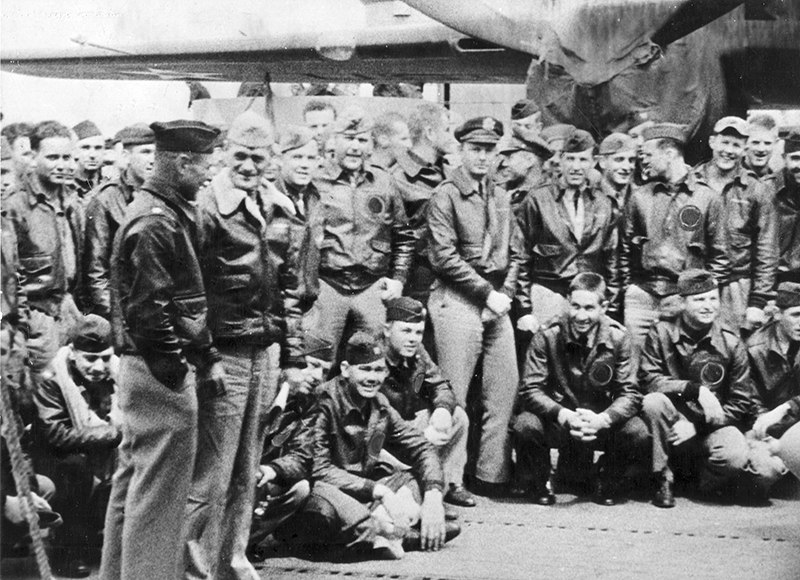82 years ago today Lieutenant Colonel James H. Doolittle led the audacious first U.S. airstrike on mainland Japan from the aircraft carrier USS Hornet in what became known as the “Doolittle Raid”.
In the fascinating photo taken onboard the USS Hornet, Lt. Col. Doolittle stands to the left of (then) USS Hornet Capt. Marc Mitscher. In his left hand Capt. Mitscher holds a large document loosely folded in half. According to information about the photo, the document is the official order directing the task force to strike Japan.
Another interesting detail in the photo is the editing of the unit patches on the aircrew leather jackets for operational security.
While the details of the Doolittle raid have become a celebrated part of air combat history, not many people realize that, in addition to being the first U.S. airstrike on the Japanese mainland following the Japanese attack on Pearl Harbor only 132 days earlier, this was also the first operational use of the North American B-25 Mitchell bomber. The aircraft had made its first flight on August 19, 1940, less than two years earlier. Every aviation fan knows the B-25 Mitchell went on to become one of the most successful combat aircraft of WWII.

Another interesting and seldom mentioned bit of trivia about the Doolittle raid happened more than three years after the April 18, 1942 raids took place.
On August 9, 1945, when the B-29 Superfortress, Bockscar, barely made it to the island of Okinawa after its nuclear strike on Nagasaki, the aircraft commander, Major Charles W. Sweeney, actually met James Doolittle on Okinawa. It was an ironic coincidence, given Doolittle’s status as the first commander to lead a strike force against mainland Japan and Sweeney’s new claim to history as being the last to deliver a nuclear weapon to a target on mainland Japan. The meeting was even more unlikely considering that Bockscar had not originally planned to land on Okinawa, it only diverted there because of its fuel emergency. The meeting between Sweeney and Doolittle, while historically significant, was utterly random. History makes no mention of whatever conversation the two may have had, but it was likely fascinating.
While the Doolittle raids and the concept of launching a heavy bomber aircraft from an aircraft carrier was entirely untried before April 18, 1942, the concept gained traction after WWII.
During the Cold War the U.S. Navy introduced the North American AJ Savage three-engine bomber. The Savage was about the same size as a B-25 and used two radial piston engines and a single Allison jet engine. The Navy apparently grew attached to the idea of launching large bombers from aircraft carriers since they went on to adopt the Douglas A-3 Skywarrior and then the North American A-5 Vigilante, both large, jet powered aircraft that operated from flight decks. None of these aircraft saw significant service in the strike role, but did fulfill other missions such as aerial refueling and reconnaissance. As nuclear weapons got smaller, the necessity of having a large carrier-borne bomber disappeared.
Today, the Navy has apparently transitioned away from a carrier-based strategic aircraft strike capability, in favor of their submarine-based ballistic and cruise missile capability. The U.S. Navy’s F/A-18 Super Hornet briefly appeared in November, 2021 documentation published by the National Nuclear Security Administration, as being capable of carrying the B-61-12 guided nuclear bomb, but the Super Hornet was then quietly removed from that list in December of that year according to an article by Hans Kristensen in the Federation of American Scientists publication.
And while Lieutenant Colonel James H. Doolittle initially believed he may face a court martial following the loss of every aircraft in the Doolittle raid along with the tragic loss of six crewmen, three killed during the raid and three more executed by the Japanese after capture, he was eventually awarded the Medal of Honor while all 80 members of the raiding force were given the Distinguished Flying Cross.
Perhaps the greatest recent tribute to the Doolittle raiders has been the official naming of the Northrop Grumman B-21 Long Range Strike Bomber (LRS-B) as the “Raider” in homage to the original Doolittle Raiders.













